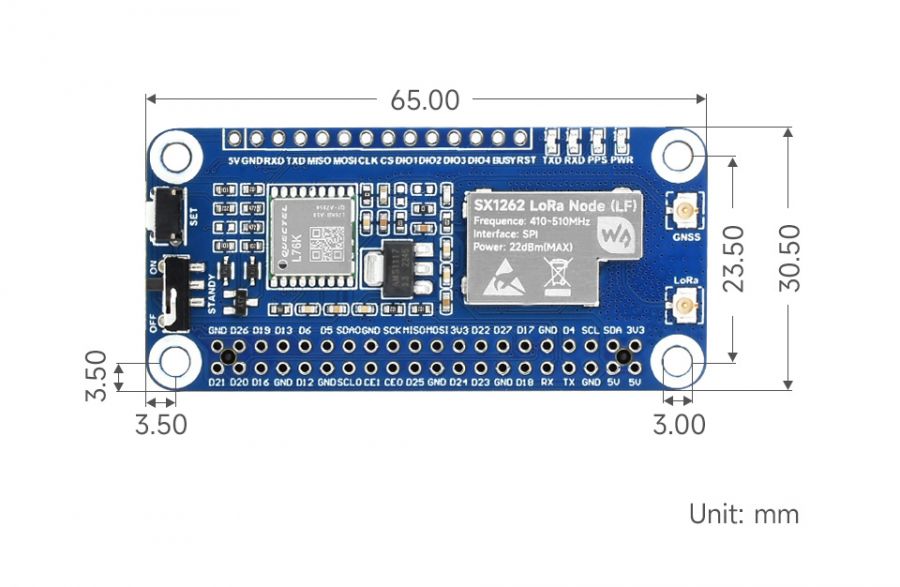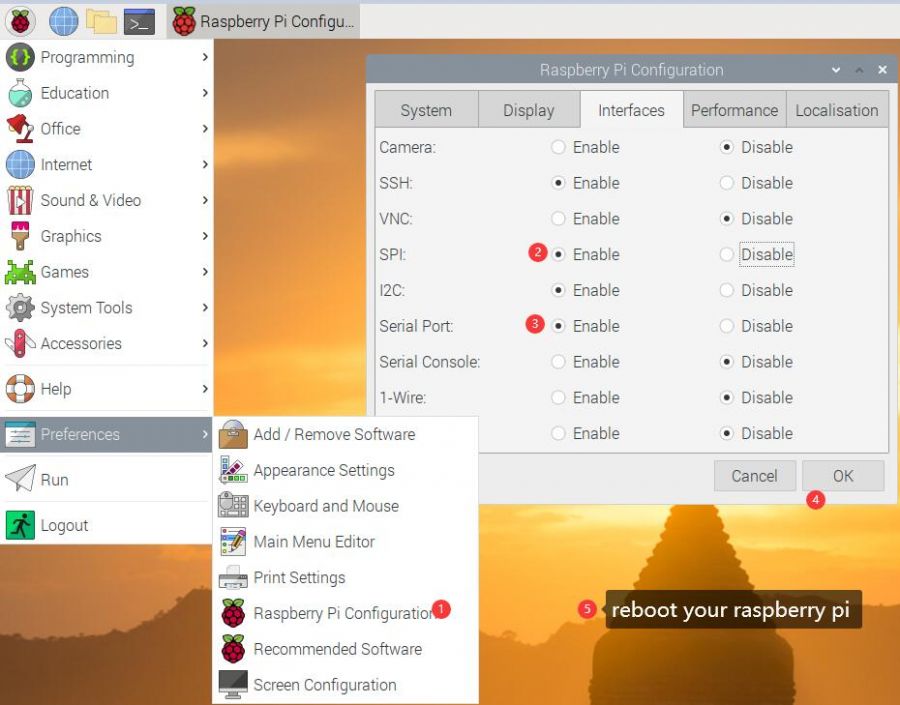SX1262 XXXM LoRaWAN/GNSS HAT
| ||
Overview
Introduction
This series of products are LoRa modules using the new generation of SX1262 RF chip, with the features of long communication distance and strong anti-interference ability. Suitable for Sub-GHz frequency band networks, and is available in LF (410~510MHz) or HF (850~930MHz) frequency band versions. Combined with a LoRa gateway, it can be connected to servers such as TTN to build a LoRaWAN network. In addition to the basic LoRaWAN version, it also provides an optional GNSS positioning function with GPS/BD support.
Features
- Common features:
- Standard Raspberry Pi 40PIN GPIO header, supports Raspberry Pi series boards.
- The new generation SX1262 has higher power efficiency and longer transmission distance than the SX1278.
- Suitable for the Sub-GHz band, combined with LoRa gateway, can be quickly connected to a cloud server such as TTN to build a LoRaWAN network.
- GNSS version features:
- Onboard L76K module with GPS/BD support, provides accurate clock and location info for node module.
- Onboard battery holder, supports ML1220 rechargeable battery, for power off preserving information and hot starts.
- Onboard 4 LED indicators for module operating status.
- Comes with online development resources and manual(example in C).
Parameters
| LORA PARAMETERS | PARAMETERS |
| RF CHIP | SX1262 |
| FREQUENCY BAND | Sub-GHz: SX1262 433/470M LoRaWAN/GNSS HAT: 410~490MHz SX1262 868/915M LoRaWAN/GNSS HAT: 850~930MHz |
| MODULATION | LoRa/(G)FSK |
| EMIT POWER | [email protected] |
| OPERATING VOLTAGE | 3.3V |
| MODULE CURRENT CONSUMPTION | transmitting current: 45mA@14dBm receiving current: 5.3mA@125KHz |
| COMMUNICATION BUS | SPI |
| OPERATING TEMPERATURE | -40 ~ 85℃ |
| DIMENSIONS | 19.00 × 22.00mm |
Hardware Description
Hardware Selection
Hardware Connection
Pinout Definition
- CS MOSI MISO CLK is the SPI interface of SX1262, and BUSY is the status pin of SX1262.
- Use MCU's SPI bus to communicate with SX1262 XXXM LoRaWAN/GNSS HAT. When MCU reads and writes SX1262 registers, it needs to read and write parameters in the order of Opcode + Address + Data. For more information, please refer to chapters 8, 10, 11, and 12 of the datasheet. The maximum SPI speed is 18MHz. The communication is shown in the figure below.
- When the MCU reads and writes the SX1262 register, it needs to detect the BUSY pin first. The low level indicates that it is idle and can be read and written normally, and the high level indicates that it is busy and cannot read and write the register, as shown in the figure below.
- RESET is the factory reset pin of SX1262, pull it low for 100us to restore the default parameters of the register, and keep a high level when working.
- RXEN, TXEN are RF single-pole switch (SPDT) pins, When RXEN is low level and TXE is high level, SX1262 is in receiving mode. When RXEN is high level, TXEN is low level, SX1262 is in transmitting mode.
- TXEN pin is connected to BCM(6), and RXEN pin is not used, which is -1 by default. Refer to the schmatic diagram, the RXEN pin is directly connected to DIO2 of SX1262. When sending,DIO2 is high and TXEN is low.
- DIO1, DIO2, and DIO3 are SX1262 functional GPIO pins, which can be set as input and output to indicate various states of SX1262 (8.5 IRQ Handling in the figure below), usually, DIO1 is set as an interrupt output in the state shown in the figure below, and DIO2 is connected to RXEN and set as the control pin of the RF single-pole switch, DIO3 is set to supply power to the TCXO, for details, please refer to Datasheet 8.3.2, 8.5 summary.
Dimensions
LoRa & LoRaWAN
What is LoRa ?
Semtech's LoRa is a long-distance, low-power wireless platform for the Internet of Things (IoT), which generally refers to radio frequency chips using LoRa technology. The main features are as follows:
- The spread spectrum modulation technology adopted by LoRa (abbreviation of long range) is derived from Chirp Spread Spectrum (CSS) technology, which is one of the long-distance wireless transmission technology and LPWAN communication technology. Spread spectrum technology uses bandwidth for sensitivity technology, Wi-Fi, ZigBee, etc. all use spread spectrum technology, but the characteristic of LoRa modulation is that it is close to the limit of Shannon's theorem, and the sensitivity can be improved with maximum efficiency. Compared with traditional FSK technology, at the same communication rate, LoRa is more sensitive than FSK by 8 ~12dBm. At present, LoRa mainly operates in the ISM frequency band of Sub-GHz.
- LoRa technology integrates technologies such as digital spread spectrum, digital signal processing, and forward error correction coding, which greatly improves the performance of long-distance communication. The link budget of LoRa is better than any other standardized communication technology. Link budget refers to the main factors that determine the distance in a given environment.
- LoRa RF chips mainly include SX127X series, SX126X series, SX130X series, of which SX127X, SX126X series are used for LoRa nodes, and SX130X is used for LoRa gateways. For details, please refer to Semtech's product list.
What is LoRaWAN ?
- LoRaWAN is an open protocol for low-power Wide Area Network(WAN), built on LoRa radio modulation technology. Designed to wirelessly connect battery-powered "things" to the Internet in regional, national, or global networks, and target critical Internet of Things (IoT) requirements such as bidirectional communication, end-to-end security, mobility, and localized services. The node wirelessly connects to the Internet with network access authentication, which is equivalent to establishing an encrypted communication channel between the node and the server. The LoRaWAN protocol level is shown in the figure below.
- The Class A/B/C node devices in the MAC layer basically cover all the application scenarios of Internet of Things. The difference among them is that the time slots for nodes to send and receive are different.
- EU868 and AS430 in the Modulation layer show that frequency band parameters are different in different countries. Please click the reference link for regional parameters.
Application
LoRa devices and networks such as LoRaWAN enable smart IoT applications to help solve the planet's formidable challenges in energy management, natural resource reduction, pollution control, infrastructure efficiency, disaster prevention, and more. Semtech's LoRa devices have achieved hundreds of successful use cases in smart cities, homes and buildings, communities, metrology, supply chain, logistics, agriculture, and more. LoRa networks have covered hundreds of millions of devices in more than 100 countries and are committed to a smarter planet.

This product test is based on TTS(The THINGS STACK) and Semtech SX1302 official library, if users build their own cloud server, please click to refer to lorawan-stack, chirpstack.
Software Description
Environment Setting
- If you are not familiar with Linux (or Raspberry Pi), please refer to the Raspberry Pi Documentation to set up the Raspberry Pi to turn on the SPI bus, etc., as shown in the following figure:
Demo Download
- Open the Raspberry Pi terminal, enter root mode, use the following command to download sample program and unzip it
sudo su wget https://www.waveshare.net/w/upload/a/a1/Sx126x_lorawan_hat_code.zip unzip Sx126x_lorawan_hat_code.zip cd sx126x_lorawan_hat_code/python/lora/ python3 setup.py install # If sudo permissions are required, add sudo in front of python3. When downloading the program for the first time, please note that you must install the library first cd examples/SX126x/ python3 transmitter.py # This sample program requires two SX1262 XXXM LoRaWAN/GNSS HAT transceiver tests. This command is applicable to the transmitter module python3 receiver_continuous.py # This sample program requires two SX1262 XXXM LoRaWAN/GNSS HAT transceiver tests, this command is applicable to the receiving module
- The sample program in the sx126x_lorawan_hat_code/python/lora/examples/network directory is a single-channel gateway and node
cd sx126x_lorawan_hat_code/python/lora/examples/network python3 LoRa_simple_node.py # This sample program requires two SX1262 XXXM LoRaWAN/GNSS HAT transceiver tests, this command is applicable to the node module python3 LoRa_simple_gateway.py # This sample program requires two SX1262 XXXM LoRaWAN/GNSS HAT transceiver tests, this command is applicable to the single-channel gateway module
Example Analysis
- This summarizes the code in transmission.py and receiver_continuous.py.
Resource
Document
Sample Demo
Datasheet
FAQ
Firmware does not support modification but can be used in the main controller to communicate and control using a demo.
{{{5}}}
Support
Technical Support
If you need technical support or have any feedback/review, please click the Submit Now button to submit a ticket, Our support team will check and reply to you within 1 to 2 working days. Please be patient as we make every effort to help you to resolve the issue.
Working Time: 9 AM - 6 PM GMT+8 (Monday to Friday)








